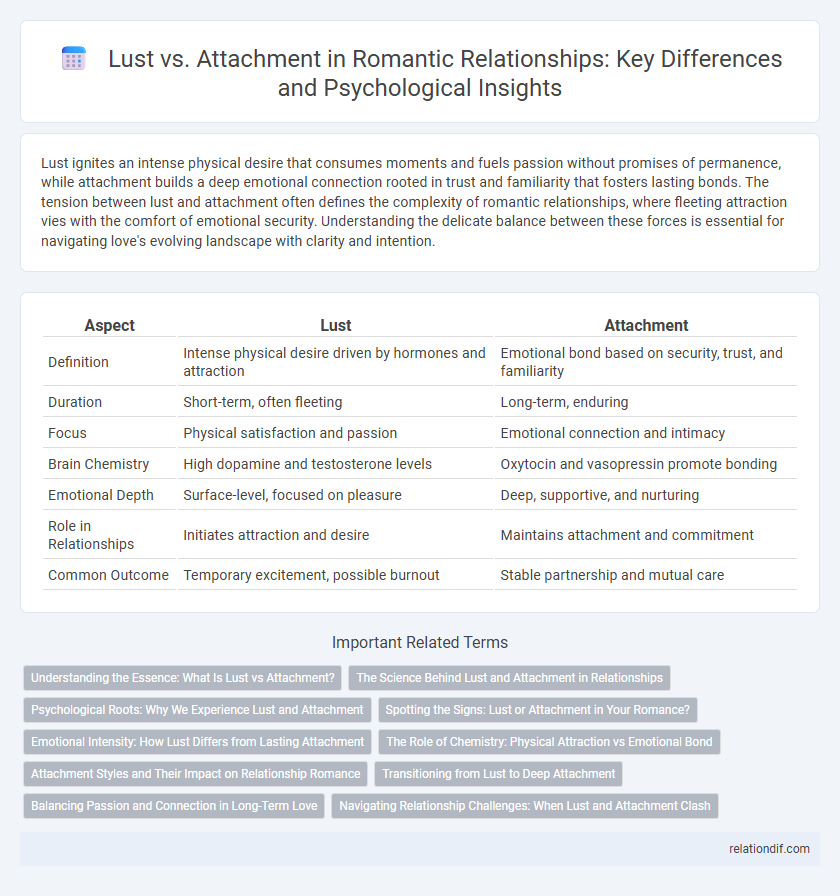Lust ignites an intense physical desire that consumes moments and fuels passion without promises of permanence, while attachment builds a deep emotional connection rooted in trust and familiarity that fosters lasting bonds. The tension between lust and attachment often defines the complexity of romantic relationships, where fleeting attraction vies with the comfort of emotional security. Understanding the delicate balance between these forces is essential for navigating love's evolving landscape with clarity and intention.
Table of Comparison
| Aspect | Lust | Attachment |
|---|---|---|
| Definition | Intense physical desire driven by hormones and attraction | Emotional bond based on security, trust, and familiarity |
| Duration | Short-term, often fleeting | Long-term, enduring |
| Focus | Physical satisfaction and passion | Emotional connection and intimacy |
| Brain Chemistry | High dopamine and testosterone levels | Oxytocin and vasopressin promote bonding |
| Emotional Depth | Surface-level, focused on pleasure | Deep, supportive, and nurturing |
| Role in Relationships | Initiates attraction and desire | Maintains attachment and commitment |
| Common Outcome | Temporary excitement, possible burnout | Stable partnership and mutual care |
Understanding the Essence: What Is Lust vs Attachment?
Lust is a powerful, physical attraction driven by hormones and desire, often fleeting and centered on immediate gratification. Attachment, on the other hand, develops through emotional bonding, trust, and shared experiences, fostering long-term connection and security. Understanding the essence of lust versus attachment clarifies how physical desire contrasts with deep emotional commitment in romantic relationships.
The Science Behind Lust and Attachment in Relationships
Lust triggers a surge of dopamine and testosterone, intensifying physical attraction and desire, while attachment involves oxytocin and vasopressin that promote bonding and long-term commitment. Neuroscientific studies show lust activates reward circuits in the brain, whereas attachment stabilizes emotional connection by reinforcing trust and safety. Understanding these distinct neurochemical pathways helps explain why initial passion may fade but attachment sustains enduring relationships.
Psychological Roots: Why We Experience Lust and Attachment
Lust stems from the brain's reward system, driven by dopamine and testosterone, triggering intense desire for physical connection and immediate pleasure. Attachment originates from the bonding hormones oxytocin and vasopressin, promoting long-term emotional stability and trust between partners. Psychological roots of lust are linked to survival and reproduction instincts, while attachment supports nurturing and cooperation essential for lasting relationships.
Spotting the Signs: Lust or Attachment in Your Romance?
Spotting the signs in your romance requires observing whether your feelings are driven by intense physical desire or a deeper emotional connection. Lust often manifests as heightened attraction, infatuation, and a focus on physical intimacy without long-term commitment, while attachment is characterized by emotional security, trust, and a desire for lasting partnership. Recognizing patterns like craving immediate gratification versus valuing consistent support helps determine if your bond is rooted in lust or genuine attachment.
Emotional Intensity: How Lust Differs from Lasting Attachment
Lust ignites intense physical attraction driven by immediate desire and hormonal surges like dopamine and testosterone, creating a high-energy emotional state. Lasting attachment involves deeper emotional bonding, characterized by oxytocin and vasopressin release, which foster trust, security, and long-term commitment. Emotional intensity in lust is often fleeting and focused on physical gratification, while attachment builds over time, promoting stability and profound connection.
The Role of Chemistry: Physical Attraction vs Emotional Bond
Physical chemistry ignites initial lust through intense attraction, releasing dopamine and adrenaline that create a powerful sensory experience. In contrast, attachment develops as oxytocin and vasopressin foster deep emotional bonds, trust, and long-term connection. Balancing these neurochemical responses ensures a harmonious relationship where passion and emotional intimacy coexist.
Attachment Styles and Their Impact on Relationship Romance
Attachment styles significantly influence romantic relationships by shaping how individuals experience lust and emotional bonding. Secure attachment fosters healthy balance, allowing passion and intimacy to coexist, while anxious attachment can heighten lust but also cause clinginess and fear of abandonment. Avoidant attachment often results in detachment, reducing emotional connection and undermining long-term romantic fulfillment.
Transitioning from Lust to Deep Attachment
Transitioning from lust to deep attachment involves moving beyond physical desire to cultivate emotional intimacy and trust. This shift requires consistent communication, vulnerability, and shared experiences that build a meaningful connection. Neurochemical changes, such as increased oxytocin and dopamine levels, reinforce bonding and deepen attachment over time.
Balancing Passion and Connection in Long-Term Love
Balancing passion and connection in long-term love requires recognizing the distinct roles of lust and attachment, where lust fuels intense desire and attachment fosters emotional security. Maintaining a healthy relationship involves nurturing physical attraction while building trust, intimacy, and shared experiences to sustain deep bonds. This equilibrium enhances relationship satisfaction, preventing the stagnation of passion or the erosion of intimacy over time.
Navigating Relationship Challenges: When Lust and Attachment Clash
Navigating relationship challenges requires understanding the fundamental differences between lust and attachment, as lust is driven by physical desire while attachment is rooted in emotional connection. Conflicts arise when partners prioritize immediate gratification over long-term intimacy, leading to misunderstandings and dissatisfaction. Cultivating open communication and emotional awareness helps balance these forces, fostering healthier and more fulfilling romantic relationships.
Lust vs Attachment Infographic

 relationdif.com
relationdif.com